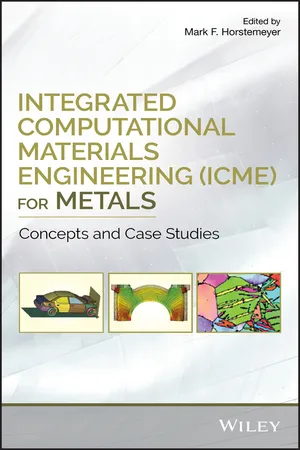
Integrated Computational Materials Engineering (ICME) for Metals
Concepts and Case Studies
- English
- ePUB (mobile friendly)
- Available on iOS & Android
Integrated Computational Materials Engineering (ICME) for Metals
Concepts and Case Studies
About this book
Focuses entirely on demystifying the field and subject of ICME and provides step-by-step guidance on its industrial application via case studies
This highly-anticipated follow-up to Mark F. Horstemeyer's pedagogical book on Integrated Computational Materials Engineering (ICME) concepts includes engineering practice case studies related to the analysis, design, and use of structural metal alloys. A welcome supplement to the first book—which includes the theory and methods required for teaching the subject in the classroom— Integrated Computational Materials Engineering (ICME) For Metals: Concepts and Case Studies focuses on engineering applications that have occurred in industries demonstrating the ICME methodologies, and aims to catalyze industrial diffusion of ICME technologies throughout the world.
The recent confluence of smaller desktop computers with enhanced computing power coupled with the emergence of physically-based material models has created the clear trend for modeling and simulation in product design, which helped create a need to integrate more knowledge into materials processing and product performance. Integrated Computational Materials Engineering (ICME) For Metals: Case Studies educates those seeking that knowledge with chapters covering: Body Centered Cubic Materials; Designing An Interatomic Potential For Fe-C Alloys; Phase-Field Crystal Modeling; Simulating Dislocation Plasticity in BCC Metals by Integrating Fundamental Concepts with Macroscale Models; Steel Powder Metal Modeling; Hexagonal Close Packed Materials; Multiscale Modeling of Pure Nickel; Predicting Constitutive Equations for Materials Design; and more.
- Presents case studies that connect modeling and simulation for different materials' processing methods for metal alloys
- Demonstrates several practical engineering problems to encourage industry to employ ICME ideas
- Introduces a new simulation-based design paradigm
- Provides web access to microstructure-sensitive models and experimental database
Integrated Computational Materials Engineering (ICME) For Metals: Case Studies is a must-have book for researchers and industry professionals aiming to comprehend and employ ICME in the design and development of new materials.
Frequently asked questions
- Essential is ideal for learners and professionals who enjoy exploring a wide range of subjects. Access the Essential Library with 800,000+ trusted titles and best-sellers across business, personal growth, and the humanities. Includes unlimited reading time and Standard Read Aloud voice.
- Complete: Perfect for advanced learners and researchers needing full, unrestricted access. Unlock 1.4M+ books across hundreds of subjects, including academic and specialized titles. The Complete Plan also includes advanced features like Premium Read Aloud and Research Assistant.
Please note we cannot support devices running on iOS 13 and Android 7 or earlier. Learn more about using the app.
Information
Chapter 1
Definition of ICME
1.1 What ICME Is NOT
1.1.1 Adding Defects into a Mechanical Theory
1.1.2 Adding Microstructures to Finite Element Analysis (FEA)
1.1.3 Comparing Modeling Results to Structure–Property Experimental Results
1.1.4 Computational Materials
1.1.5 Design Materials for Manufacturing (Process–Structure–Property Relationships)
1.1.6 Simulation through the Process Chain
1.2 What ICME Is
1.2.1 Background
Table of contents
- Cover
- Title Page
- Copyright
- Table of Contents
- List of Contributors
- Foreword
- Preface
- Chapter 1: Definition of ICME
- Section I: Body-Centered Cubic Materials
- Section II: Hexagonal Close Packed (HCP) Materials
- Section III: Face-Centered Cubic (FCC) Materials
- Section IV: Design of Materials and Structures
- Section V: Education
- Index
- End User License Agreement